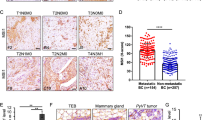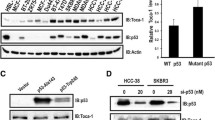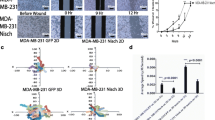Abstract
Metastatic spread of the cancer is usually the consequence of the activation of signaling pathways that generate cell motility and tissue invasion. Metastasis involves the reorganization of cytoskeleton and cell shape for the swift movement of the cells through extracellular matrix. Previously, we have described the invasive and metastatic role played by one of the members (Toca-1) of CIP4 subfamily of F-BAR proteins. In the present study, we address the role of another member (FBP17) of same family in the invasion breast cancer cells. Here, we report that the formin-binding protein 17 (FBP17) is highly expressed at both mRNA and protein levels in breast cancer cells. The study showed the association of FBP17 with cytoskeletal actin regulatory proteins like dynamin and cortactin. To determine its role in extracellular matrix (ECM) degradation, we achieved stable knockdown of FBP17 in MDA-MB-231 cells. FBP17 knockdown cells showed a defect and were found to be compromised in the degradation of ECM indicating the role of FBP17 in the invasion of breast cancer cells. Our results suggest that FBP17 is highly expressed in breast cancer cells and facilitates the invasion of breast cancer cells.




Similar content being viewed by others
References
D’Antonio C, Passaro A, Gori B, Del Signore E, Migliorino MR, Ricciardi S, et al. Bone and brain metastasis in lung cancer: recent advances in therapeutic strategies. Ther Adv Med Oncol. 2014;6(3):101–14.
Kang Y, Siegel PM, Shu W, Drobnjak M, Kakonen SM, Cordón-Cardo C, et al. A multigenic program mediating breast cancer metastasis to bone. Cancer Cell. 2003;3(6):537–49.
Eckhardt BL, Francis PA, Parker BS, Anderson RL. Strategies for the discovery and development of therapies for metastatic breast cancer. Nat Rev Drug Discov. 2012;11(6):479–97.
Yamazaki D, Kurisu S, Takenawa T. Regulation of cancer cell motility through actin reorganization. Cancer Sci. 2005;96(7):379–86.
Suresh S. Biomechanics and biophysics of cancer cells. Acta Mater. 2007;55(12):3989–4014.
Friedl P, Wolf K. Tumour-cell invasion and migration: diversity and escape mechanisms. Nat Rev Cancer. 2003;3(5):362.
Jacob A, Prekeris R. The regulation of MMP targeting to invadopodia during cancer metastasis. Front Cell Dev Biol. 2015;3(4):1–9.
Gialeli C, Theocharis AD, Karamanos NK. Roles of matrix metalloproteinases in cancer progression and their pharmacological targeting. FEBS J. 2011;278(1):16–27.
Egeblad M, Werb Z. New functions for the matrix metalloproteinases in cancer progression. Nat Rev Cancer. 2002;2(3):161.
Watson JR, Fox HM, Nietlispach D, Gallop JL, Owen D, Mott HR. Investigation of the Interaction between Cdc42 and Its Effector TOCA1 HANDOVER OF Cdc42 TO THE ACTIN REGULATOR N-WASP IS FACILITATED BY DIFFERENTIAL BINDING AFFINITIES. J Biol Chem. 2016;291(26):13875–90.
Shen H-L, Liu Q-J, Yang P-Q, Tian Y. Protein interactions of cortactin in relation to invadopodia formation in metastatic renal clear cell carcinoma. Tumor Biol. 2015;36(5):3417–22.
Park H, Cox D. Cdc42 regulates Fcγ receptor-mediated phagocytosis through the activation and phosphorylation of Wiskott-Aldrich syndrome protein (WASP) and neural-WASP. Mol Biol Cell. 2009;20(21):4500–8.
Pichot CS, Arvanitis C, Hartig SM, Jensen SA, Bechill J, Marzouk S, et al. Cdc42-interacting protein 4 promotes breast cancer cell invasion and formation of invadopodia through activation of N-WASp. Cancer Res. 2010;70(21):8347–56.
Wakita Y, Kakimoto T, Katoh H, Negishi M. The F-BAR protein Rapostlin regulates dendritic spine formation in hippocampal neurons. J Biol Chem. 2011;286(37):32672–83.
Cai B. C-terminal Eps 15 homology domain (EHD) protein-mediated membrane vesiculation and control of glycosylphosphatidylinositol (GPI)-anchored protein trafficking. Omaha: University of Nebraska Medical Center; 2013.
Livak KJ, Schmittgen TD. Analysis of relative gene expression data using real-time quantitative PCR and the 2−ΔΔCT method. Methods. 2001;25(4):402–8.
Hu J, Mukhopadhyay A, Craig AW. Transducer of Cdc42-dependent actin assembly promotes epidermal growth factor-induced cell motility and invasiveness. J Biol Chem. 2011;286(3):2261–72.
Wang W, Goswami S, Lapidus K, Wells AL, Wyckoff JB, Sahai E, et al. Identification and testing of a gene expression signature of invasive carcinoma cells within primary mammary tumors. Cancer Res. 2004;64(23):8585–94.
Chander H, Brien CD, Truesdell P, Watt K, Meens J, Schick C, et al. Toca-1 is suppressed by p53 to limit breast cancer cell invasion and tumor metastasis. Breast Cancer Res. 2014;16(6):3413.
Fricke R, Gohl C, Dharmalingam E, Grevelhörster A, Zahedi B, Harden N, et al. Drosophila Cip4/Toca-1 integrates membrane trafficking and actin dynamics through WASP and SCAR/WAVE. Curr Biol. 2009;19(17):1429–37.
Chander H, Truesdell P, Meens J, Craig AW. Transducer of Cdc42-dependent actin assembly promotes breast cancer invasion and metastasis. Oncogene. 2013;32(25):3080.
Campellone KG, Siripala AD, Leong JM, Welch MD. Membrane-deforming proteins play distinct roles in actin pedestal biogenesis by enterohemorrhagic Escherichia coli. J Biol Chem. 2012;287(24):20613–24.
Wang W, Wyckoff JB, Goswami S, Wang Y, Sidani M, Segall JE, et al. Coordinated regulation of pathways for enhanced cell motility and chemotaxis is conserved in rat and mouse mammary tumors. Cancer Res. 2007;67(8):3505–11.
Acknowledgements
We acknowledge Department of Science and Technology-Science and Engineering Research Board (DST_SERB), EMR/2015/000761, Government of India for extramural research funding to Harish Chander and Central University of Punjab for additional support. We thank Andrew Craig, Queen’s University, Kingston, Canada for Cell Lines and additional support.
Author information
Authors and Affiliations
Corresponding author
Ethics declarations
Conflict of interest
The authors declare no conflict of interest.
Rights and permissions
About this article
Cite this article
Suman, P., Mishra, S. & Chander, H. High expression of FBP17 in invasive breast cancer cells promotes invadopodia formation. Med Oncol 35, 71 (2018). https://doi.org/10.1007/s12032-018-1132-5
Received:
Accepted:
Published:
DOI: https://doi.org/10.1007/s12032-018-1132-5




